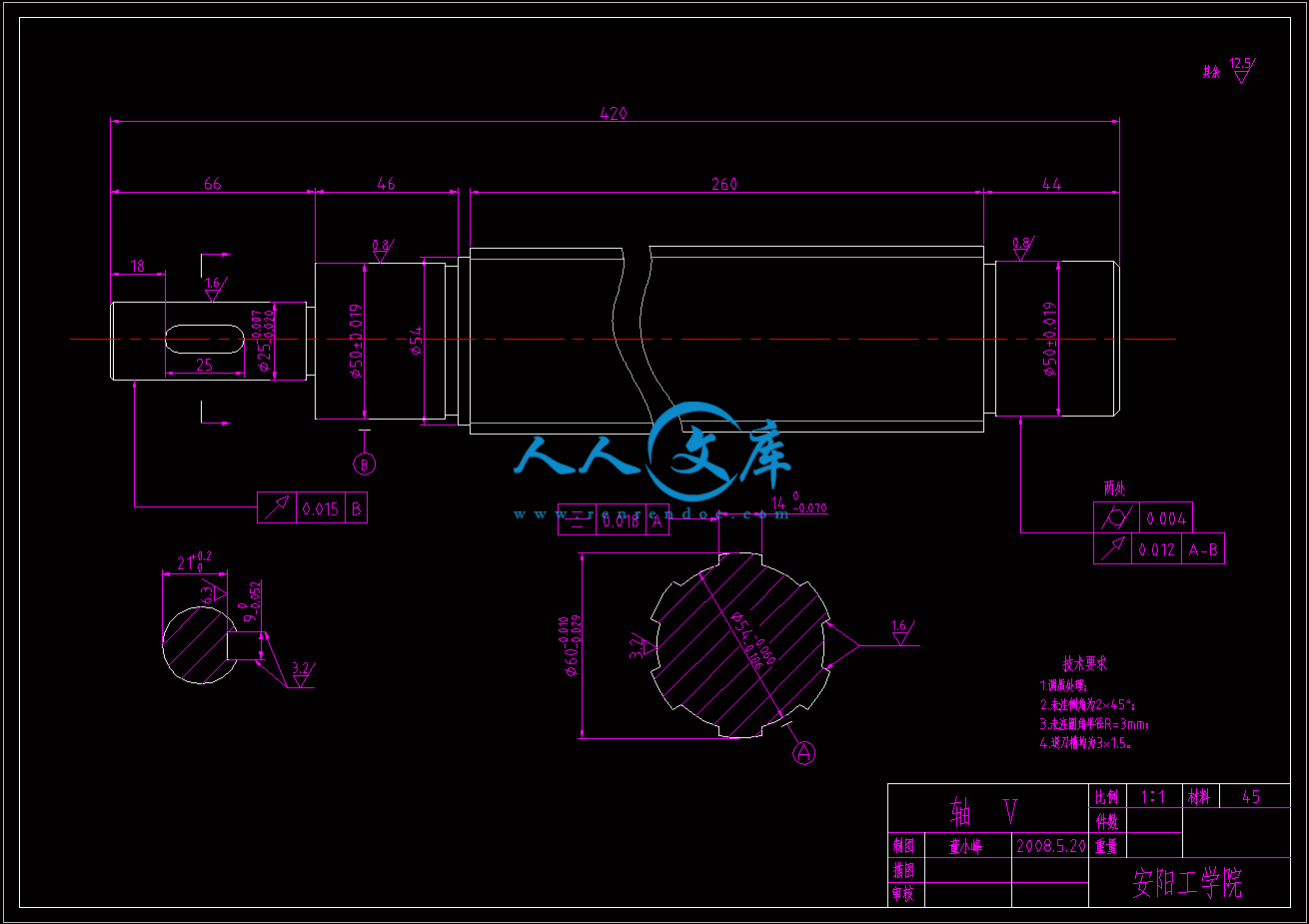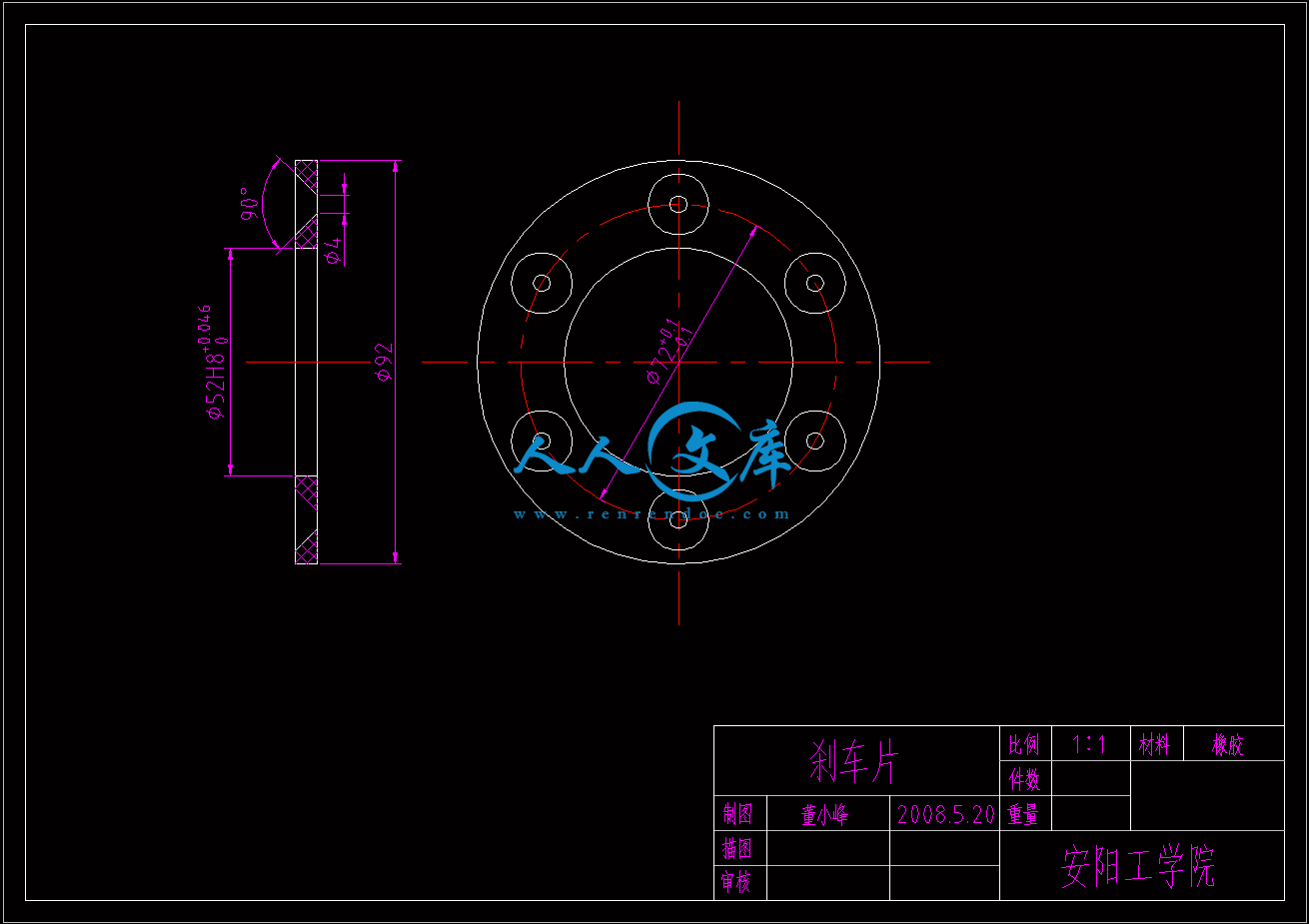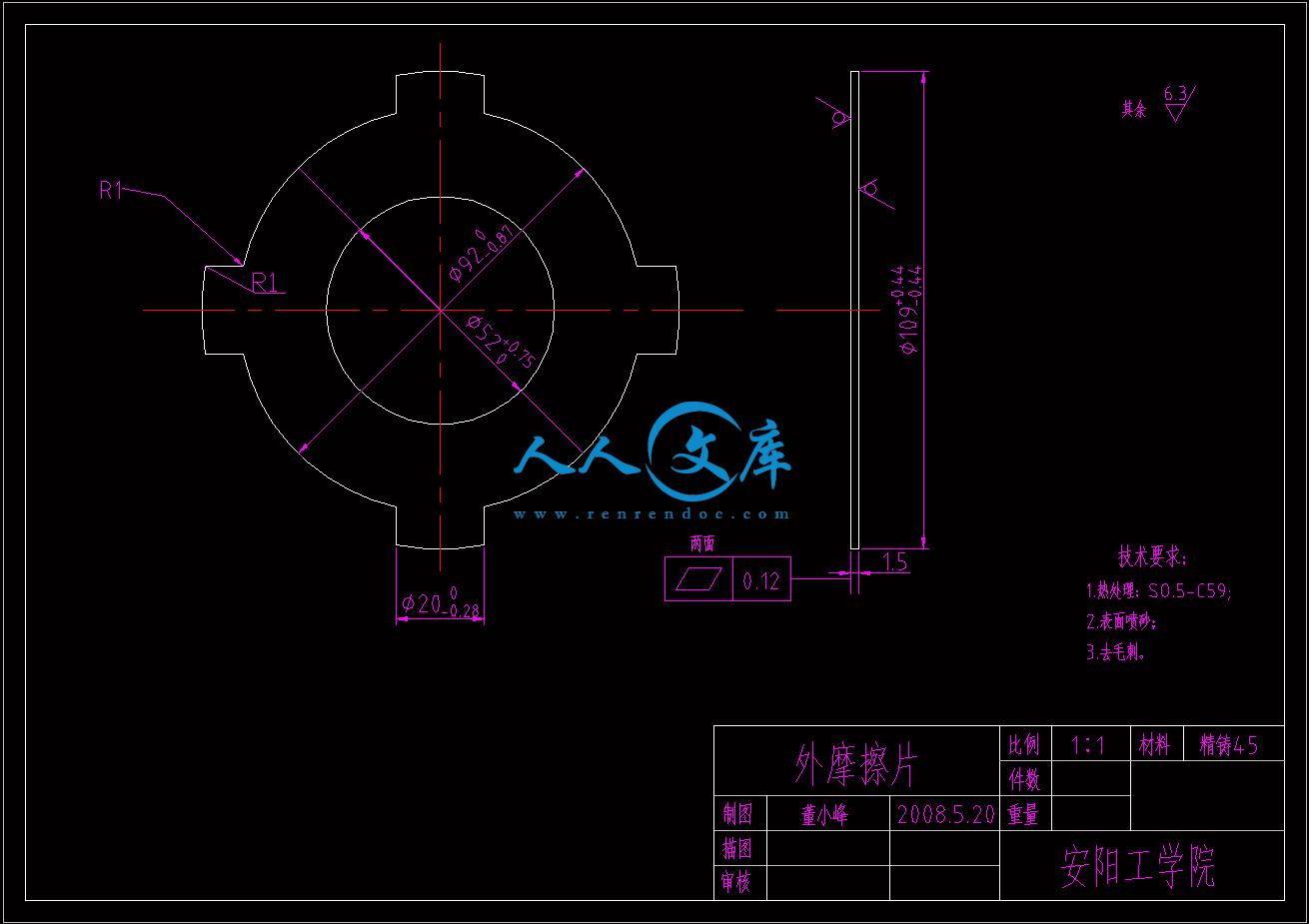QKA1219数控管螺纹车床主轴箱传动设计
31页 12000字数+说明书+任务书+开题报告+外文翻译+5张CAD图纸
5轴A3.dwg
QKA1219数控管螺纹车床主轴箱传动设计开题报告.doc
QKA1219数控管螺纹车床主轴箱传动设计说明书.doc
任务书.doc
内摩擦片.dwg
刹车片.dwg
外摩擦片.dwg
外文翻译--工业机器人.doc
封皮.doc
摘要.doc
目录.doc
答辩申请表.doc
英文皮.doc
2轴.dwg
数控管螺纹车床主轴箱传动设计
摘要 QKA1219数控管螺纹车床是安阳鑫盛机床厂设计研发并生产的。该机床主要为油田管螺纹的车削而开发,而且还适合各类管螺纹的车削,同时还可以作为普通车床使用,适合加工形状复杂的轴、套、盘类零件。
由于该机床属于半闭环控制的数控车床,比起普通车床省去了进给箱和溜板箱等机械结构,主轴箱和刀架之间的内联系传动链由数控系统和伺服系统代替。所以,主轴箱的功用不仅仅是支承主轴并把动力经变速传动机构场传递给主轴,还要考虑车床的数控化等要求,这就使得主轴箱的设计显得极为主要。
本论文的课题是QKA1219数控管螺纹车床的主轴箱传动设计。主要从传动方案的论证和选择,结构网的选择和转速图的拟定等方面来阐述这个课题。
关键词:数控 机床 主轴箱 校核?? 管螺纹
Design of headstock of QkA1219 numerical control lathe which machining pipe thread
Abstract QKA1219 pipe thread machining numerical control lathe is designed and produced by AnYang XinSheng cooperation. This kind of lathe is mainly developed for oil fields to machining pipe thread. Besides, it also can machine other kind of parts as a normal lathe.
Being a semi-loop controlled NC lathe, this lathe have no feedbox and apron compared with normal lathe, the drive chain between headstock and tool slide is replaced by CN and servo system, so, the purpose of the headstock is not as it in a normal one, and we also should consider of other aspects, hence, the design of headstock becoming very important.
This paper is mainly about this lathe’s headstock drive design. And I show my point mainly from the choose of speed diagram, choose and testimony of the design manner and so on.
Key words NC Machine tools Spindle box Check pipe thread.
目录
第一章 绪论…………………………………………………………………………………1
1.1 课题的背景及意义……………………………………………………………1
1.2 数控机床国内外发展现状…………………………………………………………2
1.3 本论文主要研究内容……………………………………………………………4
第二章 主轴箱参数的确定……………………………………………………………5
2.1车床的参数和规格…………………………………………………………5
2.2公比和最大相对转速损失率………………………………………………5
2.3动力参数的确定和电机的选择……………………………………………5
第三章 传动方案的设计………………………………………………………7
3.1传动顺序组的安排………………………………………………………………7
3.2 传动结构式和结构网的选择…………………………………………………11
3.3转速网的拟订…………………………………………………………………12
第四章 传动件的估计和确定…………………………………………………14
4.1 带轮传动的确定………………………………………………………………14
4.2 齿轮齿数的确定………………………………………………………………18
4.3 传动轴的估算…………………………………………………………………18
4.4 齿轮模数的估算………………………………………………………………20
第五章 传动结构简图的设计…………………………………………………23
5.1 结构设计的要求………………………………………………………………23
5.2 结构细节的内容………………………………………………………………24
5.3主轴箱传动结构简图………………………………………………………………26
结论………………………………………………………………………………………27
致谢……………………………………………………………………………………………28
参考文献…………………………………………………………………………………29
本课题研究的主要内容是QKA1219数控管螺纹车床的主轴箱传动部分。
该机床主要为油田管螺纹的车削而开发,且适合于各类管螺纹的车削,还可作普通数控车床使用。
该机床属于半闭环控制系统的简式数控管螺纹车床,可以加工以各种曲线为母线的连续的回转体,加工分辨为0.001mm。可加工圆柱、锥面螺纹,以及圆柱与锥面连续连接螺纹、端面螺纹。具有刀具自动补偿功能,具有坯料循环、加工螺纹循环、切槽循环。可任意设定绝对零点。适合多品种、中小批量的轮番加工,工艺适应性强、效率高,成品一致性好。编程容易,操作简单,是理想中的中型机械加工设设备。
QKA1219数控管螺纹车床是将CW系列车床进行数控改造而成的,引进了液压系统从而可以实现8级转速中的4级变速的自动化,由于引进了伺服系统和数控系统,实现了机床的数控化,与普通机床相比省了进给箱和溜板箱,不仅提高了机床的加工精度,而且大大减少了机械设计的繁杂。它与普通机床的具体不同之处在于:主轴箱的运动不再传递给进给箱,而是直接传递给一个脉冲发生器,从而省略了机械内联系传动链,脉冲发生器发出的脉冲被送到脉冲处理器,并经过由数控系统传来的数控编程指令相应的处理,最后到达控制纵向和横向运动的伺服电动机,这样就可以加工出各种复杂形状的轴类零件;但要加工螺纹,还要在加工过程中不乱扣,引进一个脉冲相位处理器就可以实现这个功能。
本课题的主要任务就是利用引进的液动系统来实现主轴箱的4级自动换挡,改进机床的机械结构,实现整个机床的数控化,从而使机床获得较高的生产效率和加工表面质量。
第二章 主轴箱参数的确定
2.1车床的参数和规格
表2.1主要规格
加工最大管子直径主轴通孔直径床身上最大回转直径刀架最大回转直径两顶尖距离最大车削长度
190mm200mm770mm480mm750/1000/1500mm550/800/1300mm
表2.2轮廓尺寸要求
规格长度宽度高度净重
7500 1000 15002912 3227 3612171517453.7 3.9 4.2
2.2 公比和最大相对转速损失率
由已知主轴的最大转速和最小转速分别为450r/min 和90r/min ,那么可以知道主轴箱的转速比:
(2-1)
又因为主轴的转速级数z=8,那么由:
(2-2)
得
最大相对转速损失率为:
% (2-3)
2.3动力参数的确定和电机的选择
机床主运动的功率,包括切削功率 空转功率损失和附加机械摩擦损失三部分。
进行切削加工时,要消耗切削功率。QKA数控管螺纹车床是专用车床,但也可以当作普通车床使用,所以切削功率与车床的刀具材料、工件材料和切削用量的大小有关。本车床所用的刀具材料为中低碳钢,由公式:




 川公网安备: 51019002004831号
川公网安备: 51019002004831号